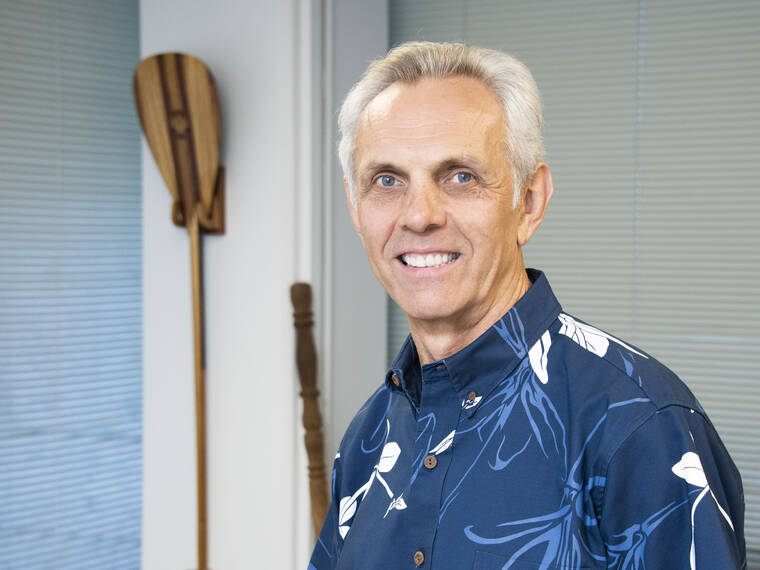Hawaii County Mayor Mitch Roth expressed optimism Monday about the current downward trend in daily coronavirus case counts and the anticipated return of larger events.
“We are very much looking forward to having those bigger events come back,” said Roth during the Honolulu Star-Advertiser’s “Spotlight Hawaii” livestream program. “We’re working with the Merrie Monarch people, and we believe that this year we will have a Merrie Monarch, if things keep on going the way they’re progressing. Right now, with the numbers coming down, we’re hoping that things are looking a lot better by the time we have our Merrie Monarch or by the time we have Ironman or some of these larger events.”
Merrie Monarch has announced plans to move forward with its hula competition at Edith Kanaka‘ole Stadium in Hilo — usually held after Easter Sunday — but would not be selling tickets to the public. And organizers of the Ironman World Championship, for the first time in decades, moved the event outside of Hawaii to Utah due to the pandemic, but have scheduled its return to Kona in October.
On Monday the state Department of Health reported 1,513 new confirmed and probable infections statewide, bringing the state’s totals since the start of the pandemic to 219,288.
The seven-day average of cases, at 1,938 Monday, has been trending down for the past week and represents a 55% drop from two weeks ago, although the average positivity rate remains unknown.
DOH stopped posting positivity rates, or the percentage of people testing positive, in mid-January because its electronic data collection system was overwhelmed. There was a staggering total of new COVID-19 infections in January alone — upward of 100,000, or nearly half of the state’s overall total.
On the hospital front, numbers appear to be declining, according to Hilton Raethel, president and CEO of the Healthcare Association of Hawaii. On Monday the state’s dashboard listed 344 patients with COVID-19 in hospitals, a 14% drop from the peak of 401 last week and down from 373 on Friday.
So far, the count of hospitalizations has not reached the same high as during the delta surge despite a record high in infections, he said.
However, Raethel said hospitals are quite full, with about 2,300 patients in hospital beds. He added that a drop to more comfortable levels — below 100 — is not expected until late February.
“It’s coming down but it’s coming down relatively slowly,” said Raethel. “Very clearly, the daily infection rate, the seven-day rate, the 14-day rate, all of those numbers have come down. So from an infection perspective, we have hit the peak and are coming down.”
But the intensive care unit numbers have not come down. Of the 344 patients hospitalized Monday, 53 were in intensive care, including 33 on ventilators.
Additionally, many of Hawaii’s health care workers are still out sick due to infections or exposure to the coronavirus, although that tally has declined by about half, he said.
Over the weekend another 72 federally funded traveling nurses and health care workers from the mainland arrived to help, bringing the current total to 745 temporary personnel.
At Hilo Medical Center, administrators have opened up beds in overflow areas after the hospital reached capacity, according to spokeswoman Elena Cabatu.
Some patients have been placed in the obstetrics unit, and others have gone to a 24-bed unit set up in the long-term care facility.
There was a high of 25 COVID-19 patients a little over a week ago, but the number dropped to 16 Monday, with three in intensive care and one on a ventilator.
The hospital continues to be very full, with both COVID-19 and non-COVID-19 patients. Part of the challenge, said Cabatu, is that long-term facilities are unable to accept new admissions due to their own coronavirus exposures and positives.
Roth shared on “Spotlight Hawaii” that he tested positive for the coronavirus in late December despite being vaccinated and boosted after his son flew home from college for Christmas.
Roth, who suffered a heart attack in 2021, said he experienced coldlike symptoms for a few days but never had symptoms such as loss of sense of taste or massive headaches. “I did get chills one day,” he said, “and maybe a little bit of a fever. But it came, it went, I’m back and I feel great.”
In late December Roth set a new limit on indoor social gatherings to 10 during the omicron surge but said he was not looking to add further restrictions.
Roth said he did not think it was necessary to implement a vaccine mandate to enter certain businesses on Hawaii island. Also, he said this would not be a good time for the state to add a booster requirement to its Safe Travels program.
Noting that the hospitality industry has expressed concerns about the impacts of adding a booster requirement, he pointed out that if new cases continue declining, implementation of the requirement might not have much effect. Roth said he does, however, encourage people to get boosted.
DOH reported Monday that 74.8% of the state’s population has completed the primary COVID-19 vaccine series, with 34.5% boosted. Hawaii County has the lowest vaccination rate of all four major counties, with only 66% vaccinated and 32% boosted.
One virus-related death was recorded Monday on Oahu, bringing Hawaii’s COVID-19 death toll to 1,181.

